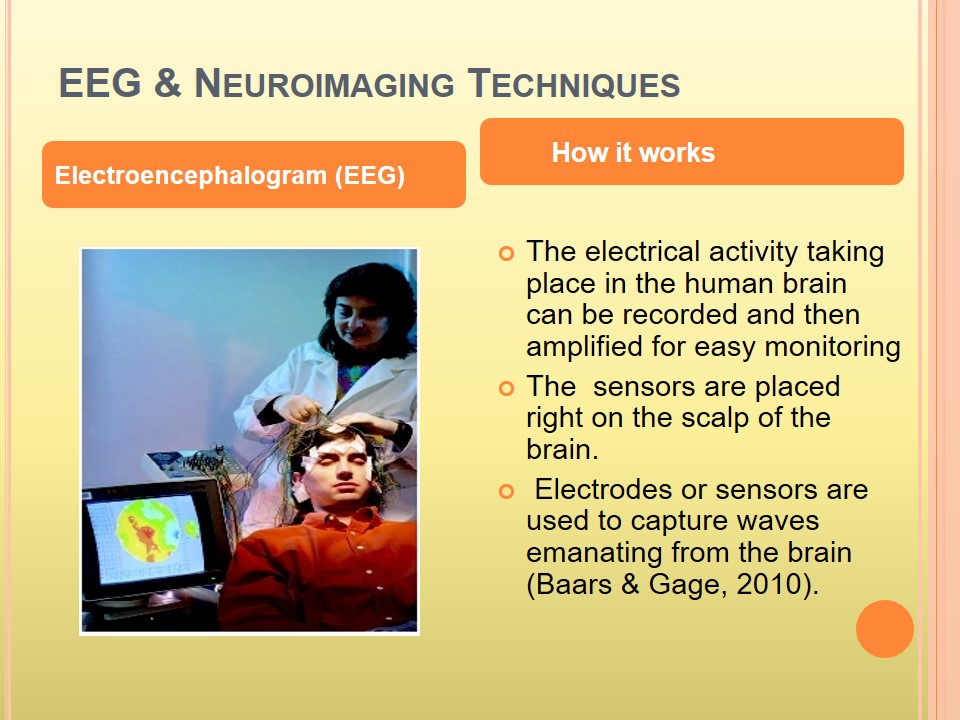Accident-Related Methods
Phineas Gage Technique
How itworks:
- Phineas Gage survived brain injury after a catastrophe with an iron rod.
- This technique scrutinizes the behavioral pattern of an individual after some brain damage caused by an accident (Nevid, 2008).
This method is a case study of Phineas Gage who survived a brain injury. It has very minimal control on experiments. However, circumstances that cannot be quantified in the laboratory can be handled using this method. Besides, the connection between the structure and function of the brain can be studied.

Lesions Technique
Mode of Operation:
- The behavioral characteristics of an individual is examined especially after undergoing damage of the brain owing to infections, psychosurgery or factors related to genes (Pinel, 2007).
- Entails removing or destroying a section of the brain (Baars & Gage, 2010).
Some parts of the brain structure is destroyed or lesion and then after the recovery of the individual, the degree of the damage is assessed against behavioral patterns.

EEG & Neuroimaging Techniques
Electroencephalogram (EEG)
How it works:
- The electrical activity taking place in the human brain can be recorded and then amplified for easy monitoring.
- The sensors are placed right on the scalp of the brain.
- Electrodes or sensors are used to capture waves emanating from the brain (Baars & Gage, 2010).
The resolution of this technique is temporarily high. Besides, the method is not invasive since the procedure is relatively painless. However, this brain study method has a poor spatial resolution.

Computerized Axial Tomography scan
Mode of operation:
- The three dimensional (3D) image of the structure of the brain is captured.
- This is done using rotating X-ray cameras positioned on the head of an individual under examination (Roe, 2009).
The method gives a very high resolution of the structure of the brain. The amount of radiation exposed to an individual should be regulated because it can lead to brain damage (killing of brain cells). The information on the function of the brain is not provided by this method.

Positron Emission Tomography (PET) scan
Mode of Working:
- Glucose that is radioactive in nature is an important component of the brain.
- In order to determine the level and rate of consumption of this radioactive glucose, Positron Emission Tomography (PET) scan is used (Baars & Gage, 2010)
The technique provides reliable information on the functioning of the brain. For instance, sections of the brain that consumes the most amount of energy can be analyzed or determined by researchers using Positron Emission Tomography scan. The machines that are required to make radioactive isotopes are expensive. In addition, the process is long and requires injection of the desired radiation.

Magnetic Resonance Imaging (MRI)
How it Works:
- There are countless atoms located in the brain.
- These atoms can be disoriented when exposed to a powerful magnetic field.
- Hence, MRI is used to produce signals emanating from soft brain tissues which are then analyzed for defects (Nevid, 2008).
- MRI produces stronger signals than that of X-rays.
The structure of the brain can be determined without the use of radiation. The procedure is not painful.

Functional Magnetic Resonance Imaging (fMRI)
How it Works:
- This type of Magnetic Resonance Imaging assists in determining the quantity of blood that flows through the brain at nay given time(Roe, 2009).
- Different parts of the brain are examined with this type of study.
- The amount of oxygen consumed is also imperative in studying the functioning of the brain using this technique.
The imaging process is quick and the technique also gives spatial resolution that is quite high. Although this method is painless, it may be uncomfortable to go through the experience.

References
- Baars, J.B. and Gage, M.N. (2010). “Cognition, Brain, and Consciousness: Introduction to Cognitive Neuroscience”, Burlington: Elsevier Ltd.
- Nevid, S.J. (2008). “Psychology: Concepts and Applications”, Boston: Houghton Mifflin Company.
- Pinel, J.P.J. (2007). “Basics of Biopsychology”, Boston: Allyn & Bacon.
- Roe, W.A. (2009). “Imaging the Brain with Optical Methods”, New York: Springer.